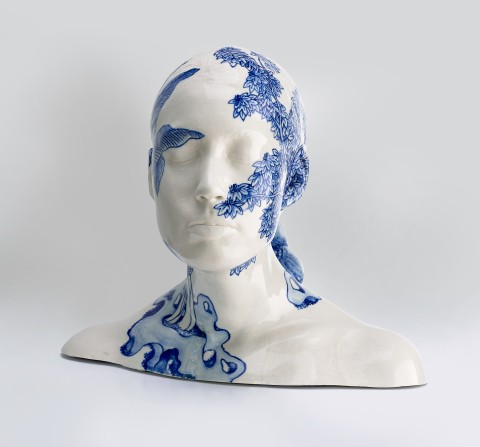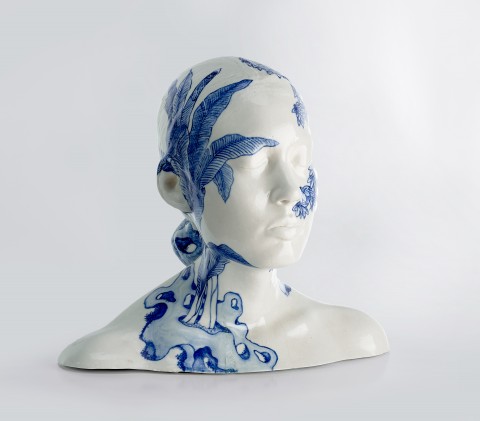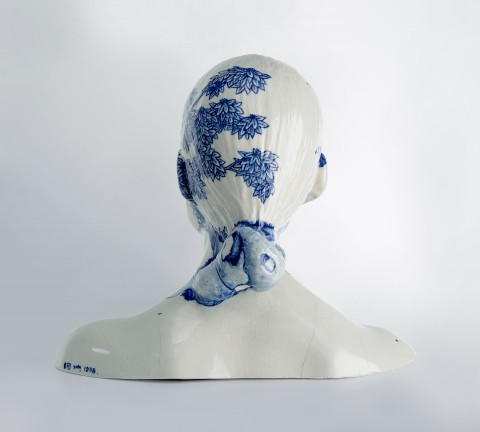CHINA CHINA - BUST 6, 1998
AH XIAN
porcelain, cast from figure, with hand-painted cobalt underglaze and clear glaze
28.0 x 32.5 x 22.5 cm
signed in Chinese characters and dated at base
signed, dated and inscribed with title on base: Ah Xian. 1998. 10. 20 Sydney / China. China - Bust 6
Private collection
Deutscher~Menzies, Melbourne, 28 November 2002, lot 92
Joan Clemenger AO and Peter Clemenger AO, Melbourne
China China – Bust 1, 1998, cast porcelain with hand-painted underglaze, 30.0 x 41.5 x 23.0 cm, in the collection of Queensland Art Gallery | Gallery of Modern Art, Brisbane
China China – Bust 15, 1999, cast porcelain with hand-painted underglaze, 35.0 x 37.0 x 20.0 cm, in the collection of the National Gallery of Australia, Canberra
Perfectly poised with her eyes closed and full lips pouting, head slightly turned towards the viewer, the bust of this anonymous female figure remains hermetically sealed in a private, peaceful meditation. Made from lustrous white porcelain, Ah Xian’s China China – Bust 6, 1998 was cast from life, her delicate features and low chignon overlaid with hand-painted vivid cobalt botanical designs of the Qing dynasty. A very early example of Ah Xian’s breakthrough and celebrated sculptural suite, China China, this minimal bust is presented simply with no plinth, its base sharply cut off at the collarbones in the manner of Western European Medieval reliquary sculpture. The surface retains minute naturalistic details of its original sitter, underscoring yet never revealing her individuality. The painted banana-leaf and maple design (symbolising precious attributes of a scholar and strength/stability respectively1) sprouting from twisting and craggy rocks unobtrusively frames contours of her head and face, covering her ears while leaving large areas of pure negative space.
Ah Xian is amongst the most accomplished practitioners of ceramic sculpture in contemporary Australian art. From his earliest explorations into ceramic casts in the late 1990s to life-size cloisonné works and bronzes, the artist’s practice elevates the individual to a semi-divine icon through a culturally specific, iconographic exploration of the Chinese diaspora in the West. Beijing-born, Ah Xian sought asylum in Australia in 1990, a member of what has now been labelled chuguore ‘leave-the country-fever’, a political and artistic exodus in the wake of the 1989 Tian’anmen Square massacre.2 Although his first artworks in Australia were dark political paintings and works on paper, by the late 1990s Ah Xian had pivoted to sculpture, experimenting with porcelain, one of China’s most culturally significant inventions. The first works of the ongoing China China series, including Bust 6, cast from the artist’s friends and family, were fired in Sydney at the Ceramics department of the UNSW College of Fine Arts, bearing the unevenness of hand-made authenticity. Following this, Ah Xian won an Australia Council for the Arts grant to study in Jingdezhen, Jiangxi Province, the historical centre for porcelain pottery since the first Ming emperors of the 14th century, the resulting works becoming increasingly uniform and lavish in their decoration.3 Examples from the China China series are highly prized, with four of the earliest examples held in the collection of QAGoMA and individual busts held in the AGSA, NGV, MCA and NGA, amongst others. Ah Xian’s subsequent explorations into busts cast in concrete, Concrete Forest, won him the final triennial Clemenger Contemporary Art Award to be offered in 2009.
Reflecting on his homeland with the geographic and temporal distance of an émigré, Ah Xian’s works focus on the beauty and mythological power of Chinese materials and symbols, which he then fuses with Western sculptural forms (China having no endemic tradition of the bust preceding its importation from the USSR at the advent of Communism).4 Ah Xian thus expresses the tensions and pride of the fragmented cultural hybridity of contemporary multicultural Australia. Creating a suite of anonymous figures, each one’s surface more lavishly and preciously adorned than the next, Ah Xian elevates the simple individual to a higher plane of dignity and authority. Their slightly translucent white porcelain evoking the pale lead-painted skin of the imperial Chinese court and providing a blank canvas for the application of hand-painted patterns. These protective tattoos and cocoons are fused to their bodies, indicating an inescapable cultural impression, from which they derive an ancient, imperial power and beauty.
1. Eberhard, W., A Dictionary of Chinese Symbols, Routledge & Kegan Paul, London and New York, 1986, pp. 30, 179
2. Chiu, M., ‘China from afar’, Ah Xian Sculpture, Städtische Museen Heilbronn, Germany, 2007, p. 11
3. Desmond, M., Portrait Profile: Dr John Yu, National Portrait Gallery, Canberra, 2009, n. p
4. Brunner, D., ‘The Bust and Immortality’ in Ah Xian Sculpture, ibid., p. 44
LUCIE REEVES-SMITH


